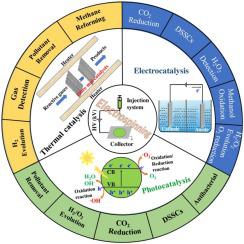当前位置:
X-MOL 学术
›
J. Ind. Eng. Chem.
›
论文详情
Our official English website, www.x-mol.net, welcomes your
feedback! (Note: you will need to create a separate account there.)
Progress in fabrication of one-dimensional catalytic materials by electrospinning technology
Journal of Industrial and Engineering Chemistry ( IF 5.9 ) Pub Date : 2021-01-01 , DOI: 10.1016/j.jiec.2020.09.016 Silong Zhu , Longhui Nie
Journal of Industrial and Engineering Chemistry ( IF 5.9 ) Pub Date : 2021-01-01 , DOI: 10.1016/j.jiec.2020.09.016 Silong Zhu , Longhui Nie

|
Abstract Electrospinning technology is regarded as a simple, versatile, and cost-efficient approach in fabricating one-dimensional (1D) nanomaterials in a large scale. The prepared 1D fiberous materials by electrospinning technology possess the merits of large specific surface area, tunable chemical composition, morphology, fiber diameter and high porosity, causing them to be extensively applied in the field of catalysis. In this review, we firstly have a brief introduction to the working principle of electrospinning technology and the influence factors to the electrospun materials. Then, we highlight the investigations of various 1D electrospun fiberous catalytic materials in the applications of photocatalysis, thermocatalysis, electrocatalysis, and the relations between catalytic properties with composition, unique 1D structure and morphology as well as related catalytic mechanisms are summarized and discussed. Finally, a conclusion is presented and future work is prospected.
中文翻译:

静电纺丝技术制备一维催化材料研究进展
摘要 静电纺丝技术被认为是一种简单、通用且具有成本效益的大规模制造一维 (1D) 纳米材料的方法。采用静电纺丝技术制备的一维纤维材料具有比表面积大、化学成分可调、形貌、纤维直径和孔隙率高等优点,使其在催化领域得到广泛应用。在这篇综述中,我们首先简要介绍了静电纺丝技术的工作原理以及对静电纺丝材料的影响因素。然后,我们重点介绍了各种一维电纺纤维催化材料在光催化、热催化、电催化应用中的研究,以及催化性能与组成之间的关系,总结和讨论了独特的一维结构和形态以及相关的催化机制。最后,得出结论并展望未来的工作。
更新日期:2021-01-01
中文翻译:

静电纺丝技术制备一维催化材料研究进展
摘要 静电纺丝技术被认为是一种简单、通用且具有成本效益的大规模制造一维 (1D) 纳米材料的方法。采用静电纺丝技术制备的一维纤维材料具有比表面积大、化学成分可调、形貌、纤维直径和孔隙率高等优点,使其在催化领域得到广泛应用。在这篇综述中,我们首先简要介绍了静电纺丝技术的工作原理以及对静电纺丝材料的影响因素。然后,我们重点介绍了各种一维电纺纤维催化材料在光催化、热催化、电催化应用中的研究,以及催化性能与组成之间的关系,总结和讨论了独特的一维结构和形态以及相关的催化机制。最后,得出结论并展望未来的工作。











































 京公网安备 11010802027423号
京公网安备 11010802027423号